If you own a boat or any metal equipment that’s frequently exposed to water, you know how crucial it is to have the right protective coatings. The marine environment can be tough on metal surfaces, with constant exposure to saltwater, moisture, UV rays, and harsh weather conditions.
Without proper protection, metal can corrode, rust, and degrade over time, which can lead to costly repairs or replacements. We’ll explore the best marine paint for metal, provide helpful tips on choosing the right paint for your needs, and answer frequently asked questions to ensure you make an informed decision.
Why You Need Marine Paint for Metal
Metal components of your boat or watercraft are particularly vulnerable to corrosion and rust due to the constant exposure to moisture, saltwater, and extreme weather conditions. Marine paint is specifically formulated to protect metal surfaces from these elements. Here are a few reasons why marine paint is essential:
- Prevents Corrosion: Marine paint acts as a protective barrier, preventing moisture and salts from coming into direct contact with the metal, which helps prevent rust and corrosion.
- UV Protection: Marine environments expose metal surfaces to intense UV rays, which can cause fading, degradation, and weakened protective coatings. Marine paint helps shield your boat or equipment from harmful UV exposure.
- Durability: Marine paint is designed to withstand the harsh conditions of the water, such as constant water immersion, heat, and waves, ensuring long-lasting protection.
- Aesthetic Appeal: High-quality marine paints enhance the appearance of metal surfaces, providing a shiny, professional finish while also protecting the material from damage.
- Improved Safety: For boats, proper paint can also improve safety by providing better visibility and making parts of the boat more discernible in low light conditions.
Key Features to Look for in Marine Paint for Metal
When choosing the best marine paint for metal surfaces, you should consider the following features:
- Rust and Corrosion Resistance: The paint must offer exceptional protection against rust, especially in saltwater environments. Look for paints that include anti-corrosive properties or additives designed to prevent rust formation.
- Durability and Longevity: Since your boat or equipment is exposed to harsh weather conditions, the paint must be durable enough to withstand continuous water exposure, UV rays, and abrasion without wearing off quickly.
- Ease of Application: Some marine paints are easier to apply than others. For DIY enthusiasts, it’s important to select a paint that is simple to apply with minimal effort, whether you’re using a brush, roller, or spray.
- Flexibility: Marine paint should be flexible enough to withstand movement and expansion of metal surfaces, particularly on boats or ships. This flexibility helps prevent cracking or peeling over time.
- Waterproofing: Since the paint is meant for metal objects exposed to water, it should offer excellent waterproofing to prevent water damage, rust, or deterioration of the paint layer.
- Mildew and Fungal Resistance: Metal parts on boats or other marine vessels can be vulnerable to the growth of mildew or algae, especially in damp environments. A good marine paint will offer protection against fungal growth.
Best Marine Paint for Metal
Here are some of the top-rated marine paints specifically designed for metal surfaces. These options offer excellent corrosion protection, durability, and ease of use.
1. Interlux Brightside Polyurethane Paint
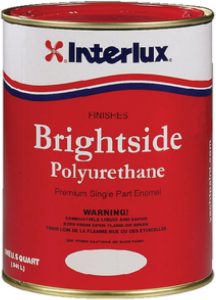
Best for: Glossy, long-lasting finish on metal surfaces.
Interlux Brightside Polyurethane Paint is a high-performance paint designed for use on boats and metal surfaces. It offers superior protection against corrosion and provides a durable, glossy finish that lasts for years. This paint is especially known for its smooth application and long-lasting color retention.
- Features:
- High-gloss finish for a professional, polished look.
- Excellent resistance to UV rays, weather, and saltwater.
- Provides a hard, durable surface that resists fading and abrasion.
- Fast-drying and easy to apply.
- Pros:
- Great for a smooth, high-gloss finish on metal.
- Easy to clean and maintain.
- Provides a durable, long-lasting protective coat.
- Cons:
- Requires proper surface preparation for optimal adhesion.
- Not suitable for use on submerged metal surfaces, like the hull of a boat.
2. TotalBoat Topside Paint
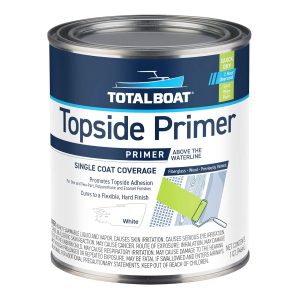
Best for: Easy application on boats and metal parts above the waterline.
TotalBoat Topside Paint is designed for use on boats, and it works perfectly on metal, fiberglass, and wood. This versatile paint is highly durable and offers long-lasting protection against the elements. Its UV-resistant formula ensures that the finish won’t fade or degrade under the sun.
- Features:
- Provides a tough, durable finish for metal surfaces.
- Resistant to mildew, fading, and cracking.
- Easy to apply with a brush, roller, or spray.
- Offers UV protection and high resistance to saltwater.
- Pros:
- Quick-drying and easy to use.
- Resistant to common marine problems like mildew and saltwater corrosion.
- Low odor and non-toxic formula.
- Cons:
- Not intended for use on underwater or continuously submerged metal.
- Requires a primer for optimal adhesion on some metal surfaces.
3. Epifanes Polyurethane Paint
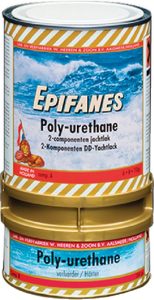
Best for: Premium, long-lasting finish with excellent protection.
Epifanes Polyurethane Paint is known for its durability and high-gloss finish. It is a premium paint option used by many boat owners to protect metal surfaces, particularly above the waterline. This paint has great resistance to UV rays, saltwater, and abrasion, making it a top choice for boat owners.
- Features:
- Long-lasting protection against the elements, including UV and saltwater.
- Excellent gloss retention and abrasion resistance.
- Can be applied directly to bare metal, fiberglass, or wood.
- Available in a range of colors for customized finishes.
- Pros:
- High-gloss finish that is both aesthetically pleasing and protective.
- Ideal for metal surfaces above the waterline.
- Easy to clean and maintain.
- Cons:
- Requires more careful application and surface preparation.
- Slightly more expensive than other marine paints.
4. Rust-Oleum Marine Coatings Topside Paint
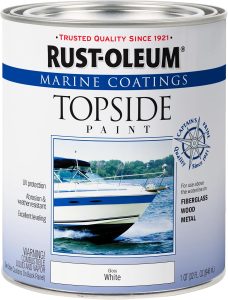
Best for: Budget-friendly, reliable protection for metal.
Rust-Oleum is a popular brand known for its effective paints across a variety of applications, and their Marine Coatings Topside Paint is no exception. This paint is designed for use on metal boats and surfaces above the waterline, offering solid protection against corrosion, UV rays, and wear.
- Features:
- High-gloss, durable finish.
- Provides excellent protection against UV rays and saltwater.
- Resistant to scratches, chips, and fading.
- Available in a variety of colors, including white, black, and navy.
- Pros:
- Affordable and easy to find.
- Provides excellent UV and corrosion protection.
- Ideal for DIY boat owners looking for reliable performance.
- Cons:
- May require multiple coats for full coverage.
- Not recommended for surfaces that will be submerged.
5. Awlgrip Topcoat Paint
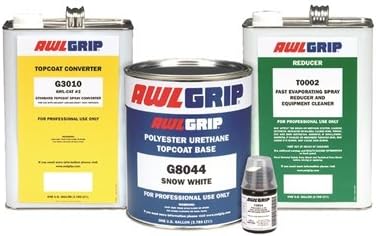
Best for: High-performance paint for professional use.
Awlgrip Topcoat Paint is a premium paint that is widely used in the marine industry, especially for large vessels. It offers exceptional protection against saltwater, corrosion, and weathering. Known for its glossy finish and resistance to fading, Awlgrip is the go-to paint for professionals and boat builders.
- Features:
- Excellent resistance to UV rays, weather, and saltwater.
- Provides a hard, durable finish that resists chipping and scratching.
- High gloss retention and long-lasting color.
- Pros:
- Known for its professional-grade finish and performance.
- Durable and resistant to harsh marine conditions.
- Available in a wide range of colors.
- Cons:
- High price point compared to other marine paints.
- Requires proper surface preparation and may need multiple coats.
How to Apply Marine Paint to Metal Surfaces
To achieve the best results with marine paint, it’s essential to prepare the metal surface properly and apply the paint correctly. Here’s a step-by-step guide to applying marine paint to metal:
- Clean the Surface: Begin by thoroughly cleaning the metal surface with soap and water to remove any dirt, oil, or grease. Use a wire brush or sandpaper to remove any existing rust or peeling paint.
- Prime the Surface: Some marine paints require a primer to ensure proper adhesion, especially on bare metal. Use a high-quality marine primer designed for metal surfaces to prevent rust and ensure a smooth base for the topcoat.
- Apply the Paint: Using a brush, roller, or spray gun, apply the marine paint in even coats. For best results, use thin coats to avoid drips and runs. Allow each coat to dry before applying the next.
- Allow Drying Time: Let the paint fully dry before subjecting the metal to exposure to water or other harsh conditions. Drying time can vary based on the paint, so refer to the manufacturer’s instructions.
- Seal and Protect: If needed, apply a clear topcoat or sealant to further protect the paint and improve its longevity.
Frequently Asked Questions
1. Can I use regular paint on a metal boat?
It’s not recommended to use regular paint on a boat because it may not provide adequate protection against the harsh marine environment. Marine-specific paints are formulated to withstand water, UV rays, and corrosion, making them the best choice for boat surfaces.
2. How long does marine paint last on metal?
The lifespan of marine paint can vary depending on the quality of the paint and exposure to harsh conditions. High-quality paints can last anywhere from 2 to 5 years, but periodic touch-ups may be required.
3. Can I apply marine paint over old paint?
Yes, you can apply marine paint over old paint, but the old paint must be in good condition. Sand or remove any peeling or chipped paint to ensure a smooth, clean surface for the new paint to adhere to.
4. What is the best finish for marine paint?
A high-gloss finish is often preferred because it provides a polished look while offering added protection against water, UV rays, and corrosion. However, satin or matte finishes can also be used for a more understated look.
5. Do I need a primer before applying marine paint?
Yes, A primer is necessary to help the paint adhere properly to the metal surface and provide an additional layer of protection. Some marine paints come with built-in primers, while others may require a separate primer for optimal results.
Conclusion
Choosing the best marine paint for metal is essential to ensure your boat or watercraft is protected from the elements. Whether you’re looking for a high-gloss finish, corrosion resistance, or long-lasting durability, the options listed above provide excellent solutions for various marine applications. Make sure to properly prepare the surface, apply the paint carefully, and maintain the finish to keep your metal surfaces looking great and protected for years to come.


Leave a Reply